|
1.
CENTRAL/ WEST AFRICA
Log prices remain firm and unchanged
Log prices remained stable and unchanged through November, except for minor increases in okan prices.
Okan LM and B log grades rose .8 per m3 for Asian destinations, bringing the prices in line with those paid by
European buyers. In terms of demand, China and India remained very active, with China favouring okan, which
gave rise to the slight price adjustment. The very firm trend in Far East prices, including forecasts of continued
upwards price movements, seemed likely to maintain the stability in demand and price levels.
Downward pressure on prices fails to materialize
Most sawn lumber prices also held firm and unchanged through the month. Ayous FAS GMS surged .30 to .396 per
m3 while douka FAS GMS jumped by the same amount to .488 per m3 fob. Speculations of a possible weakness in
prices for some sawnwood species failed to materialize as
heavy rains in Cameroon and Gabon hindered logging, keeping supply to sawmills very limited through the
period. Rains were still heavy at the end of the rainy season, affecting export volumes of logs and lumber from
Congo through the port of Douala. Overall, the market has remained active and prices very stable.
There was a slight easing in the roll on/roll off freight rates to Europe that might be favourable to sawn lumber exports
for that continent. However, exports of African tropical logs and sawnwood to Europe have been declining over
the last years.
New log quota system to be fully enforced in January
The new quota systems in Gabon and Congo were expected to come into force in January 2007. The new
regulations would impose controls and limits on the volume ratios of logs that must be processed in order to
retain a proportion of logs allowed for export. The quota system could impact more forcibly on Congo where
okoume log exports, in particular, have been increasing, whereas in Gabon these have substantially fallen in recent
years. The overall impact of the new quota allocations on the market is hard to predict but some reductions in log
availability for export could be expected.
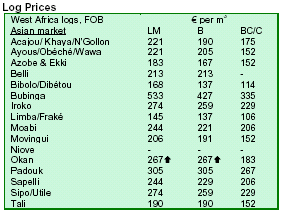
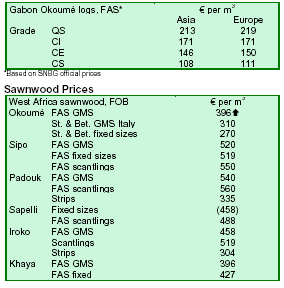
2. GHANA
Exports of timber products continue to slide
According to the Timber Industry Development Division (TIDD) of the Forestry Commission, export of wood
products reached .125.82 million (328,620 m3) in the first three quarters of 2006. This
corresponds to 8.8% and 6.7% declines in value and volume, respectively, compared with
2005. Ghana exports of timber products continued to decline as millers faced continued dwindling supply of raw materials as well as macro-economic constraints.
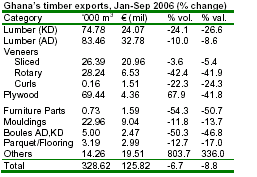
Exports of other SPWP buck downward export trend
Secondary processed wood products (SPWP, furniture parts, mouldings, flooring, etc.) accounted for 14% of the
total export volume in the period, but 28% of the export value. SPWP exports reached .35.6 million, up 35% from
2005, while primary products (lumber, veneer, plywood, etc.) totalled .90.21 million (287,470 m3), down 19%
from 2005. Exports of other processed wood products offset the decline in exports of furniture parts, mouldings
and other SPWP. Most of the SPWP were shipped to European markets, notably Italy, France, the UK,
Germany, Belgium, Spain and the Netherlands. KD and AD lumber accounted for almost half of the total export volume in the period.
Except plywood exports which surged 68% in volume, all other wood products registered lower export volumes ranging from -4% to -54% over the period. AD and KD
sawnwood exports fell 24% and 10%, respectively while lower export volumes were registered for veneers (down 4
to 42%), furniture parts (down 54%) and mouldings (down 12%). Wawa, ceiba, teak, asanfina, chenchen,
odum, papao, ofram, odum and niangon were the leading export species in the period.
Timber product exports to the US and European markets declined in volume 23 and 32%, respectively in the period.
However, exports to UAE, Nigeria, China and Saudi Arabia rose 320%, 206%, 109% and 11%, respectively,
highlighting the growing importance of these markets.
Bidding of teak and cedrela plantation timber begins
The Timber Rights Evaluation Committee (TREC) has invited applications for competitive pre-qualification
bidding for plantation timber in 27 Forest Reserves from five regions of the country. The regions are Volta (16
districts), Brong Ahafo (5 districts), Ashanti (3 districts),Western (2 districts) and Eastern (1 district). The prequalification
bidding covers about 252,591 stems from
small, medium and large scale operations, equivalent to about 147,691 m3, of which 142,450 m3 and 5,241 m3 are
teak and cedrela, respectively. Ghana¡¯s teak timber exports are mainly for the Indian market, the leading importer of teak.
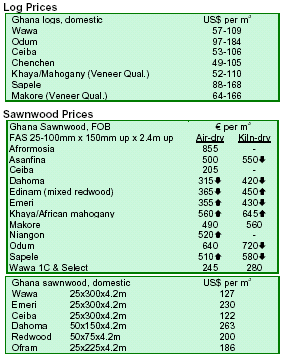
3.
MALAYSIA
Prices of timber products rise across the board
Prices for most timber products rose across the board in late November. Prices of plywood and panel products, in
particular, continued to rise, with demand from Japan unabated as the economy sustained its longest economic
expansion since World War II. Japan marked its 58th month of economic recovery since January 2002, according to the Japanese Cabinet Office.
Thunderstorms drive log prices up
Thunderstorms continued to drench much of the country, driving prices of logs up in both East and West Malaysia.
The supply of rubberwood to the furniture industry entered a critical stage as furniture sales to Middle-Eastern,
European and Central American countries picked up. Some Malaysian furniture manufacturers were negotiating
intensely with Indonesian rubber trees plantation owners in order to secure supply of raw material (see below).
Merging of furniture associations postponed
The long awaited merger between two furniture trade bodies, the Malaysian Furniture Industry Council
(MFIC) and the Malaysia Furniture Entrepreneurs Association(MFEA), was due to be concluded by mid-2007. The
president of MFIC had initially planned to call for an Emergency General Meeting (EGM) on 19 December 2006 to quicken the merger process. However, a number
of MFIC board members opposed the merger and voted to dismiss the president. The president has since launched a
legal challenge over his dismissal. This development has proven to be a trying time for the furniture sector.
MTC CEO to retire in December
The CEO of the Malaysian Timber Council (MTC) has announced his retirement as from the end of December
2006. Dato Ismail Awang had been CEO of MTC since July 1997.
Malaysia turns to Indonesia for rubberwood supply
Malaysian rubberwood furniture makers were facing a dilemma between rising demand from Europe for finished
products and difficulties to secure enough raw materials to feed production lines. To
counter this, DPS Resources Bhd planned to source timber from Indonesia where it had
identified a partner with a large rubberwood concession area. The targeted concession would be able to provide a
steady supply of rubberwood for its production over the next 10 years. DPS consumes about
25,000 tonnes of rubber timber annually to produce some 1,000 containers of furniture mainly for the export market, which is
equivalent to wood sourced from about 295 ha of mature rubber trees every year.
Generally, rubber trees are felled and replanted after 26-30 years of latex tapping. The surge of latex prices in recent
years prompted many local plantation owners to delay replanting. The shortage of timber supply, coupled with
strong demand from the timber processing industry had pushed rubberwood prices about 20% higher over the last
year. Data from the Malaysian Rubber Board (MRB) shows that the total plantation land in Malaysia had shrunk
to around 500,000 ha last year from 676,000 ha 10 years ago. Most of the rubber plantations in the country
belonged to smallholders and government agencies. About 8,000 ha of land were replanted with young rubber trees every year for the past five years.
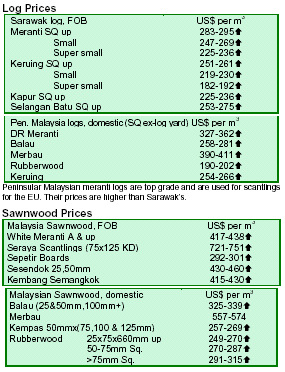
4.
INDONESIA
Prices of Indonesian timber products edge up
Prices of Indonesian plywood and panel products also rose in tandem with those in Malaysia as more Japanese
importers began to source more material from Indonesia. Prices of logs were showing signs of recovery due to the strong demand of plywood and panel products.
Japan and Indonesia sign EPA
Japan and Indonesia signed an Economic Partnership Agreement (EPA) in Tokyo recently. Under the
agreement, Indonesian timber products will have open market access to the Japanese market. Japan will scrap
some 90% of the import tariffs on forestry products but levies on plywood will be retained. The EPA would also
place the competitiveness of Indonesian products on par with other Southeast Asian countries such as Malaysia,
Thailand and Singapore. Japan is the largest foreign donor and investor in Indonesia.
USA-Indonesia agree to combat illegal logging and trade
The presidents of the USA and Indonesia recently signed an agreement that will combat illegal logging and the trade
in illegal timber in Indonesia, while promoting the trade of legal Indonesian timber products in the USA. In a joint
statement, the two presidents also praised the resumption
of cooperation and capacity building activities between the US Forest Service and the Indonesian Ministry of
Forestry.
Indonesia: EU conducts excessive checks on products
The Indonesian Forestry Department urged EU countries not to be discriminatory about Indonesian timber products.
Boen M. Purnama, Secretary General of the Indonesian Forestry Department, said that intensive efforts to
eradicate illegal logging had made the EU conduct excessive checks on Indonesian timber products. Jean
Breteche, the EU representative for Indonesia, said sanctions would be imposed on EU timber companies
found to be purchasing illegal timber products. The
sanctions would include financial penalties and import bans, although these were still being
discussed with the Indonesian authorities.
Indonesia develops plantation to boost sector¡¯s growth
Indonesia plans to develop about 500,000 ha of smallholders¡¯ forests in 2007 as part of its efforts to realize
the targeted 2-3% growth in the forestry sector, according to the Indonesian Forestry
Minister MS Kaban. He said his Ministry was trying its best to carry out three agendas in
the forestry sector. The first agenda is to achieve the forestry sector¡¯s 2-3% growth target, which is part of the
national economic growth target of 5-6% for 2009. The second agenda is to boost the forestry sector based on
small and medium-scale businesses in urban areas and timber business centers within and outside Java. The third
agenda is to empower the local people located in forests areas.
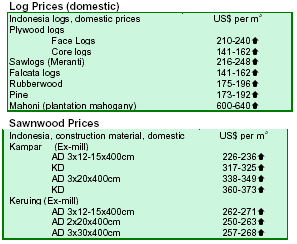
5.
MYANMAR
Prices for teak logs continue to be bullish
Prices for teak logs, except third veneer quality and assorted grades, surged in the competitive bidding held in
late November. Demand for the different teak log grades resumed its strength as participation in the teak bidding process improved in November.
Local teak processing remains subdued
There were no major changes in the sawn teak market. The trading for sawn teak remained subdued as in previous
months. The market for teak boards and decks was active. The availability of raw logs for the local teak industry
continued to be restricted despite that many Myanmar
buyers were reported to have participated in the tender sales to source raw material supply.
Prices for other logs below expectations
Pyinkadoe logs were not selling well as listed prices were said to be high. About 402 tons of pyinkado logs were sold
by sealed tender at an average price of euro390 (about $504), below the December listed price of
euro470-500. The market for fresh gurjan logs continued to be good. Although gurjan logs fetched a higher average price of
euro203 (about $263), it was still below the listed price of $295-320.
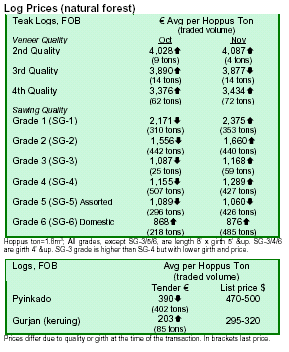
6. PAPUA
NEW GUINEA
PNG log exports recover in September
Log exports from PNG rose to 205,862 m3 in September 2006, up 18.6% from August and 29% from September
2005. Accumulated log exports in the year to September were 12% ahead of the pace last year (see chart).
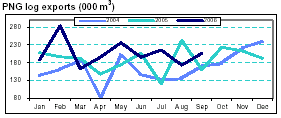 7.
BRAZIL 7.
BRAZIL
Total log exports (excluding plantation) amounted to 2.49
million m3 in the year to September 2006. Saw/veneer grades accounted for 86% of the total. Main log export
species were taun, malas, bintangor and terminalia. China took 81% of all log exports, followed by Japan (8.6%),
Vietnam (4.1%) and Korea (3.5%). Of the saw/veneer log grades, China imported 88%, Japan 6%, Korea 2.5% and
Vietnam 0.79%. For plantation species, kamarere remained the main export species primarily to the markets
of Vietnam, Japan, China and Korea.
CSAG contests news on PNG FLEG Seminar
The Civil Society Advisory Group (CSAG) has sent a letter concerning news published in the TTM Report on
the PNG Regional Seminar on Forest Law Enforcement and Governance (FLEG) last month. This is the text.
Sir - The TTM Report 11:20 contained a number of errors regarding the Regional Seminar on FLEG hosted by PNG.
Unfortunately, these errors misled and misinformed readers, thereby giving them an inaccurate understanding of the
challenges faced in PNG in advancing sustainable and legal
production of timber. Here, we would like to correct those errors and encourage the ITTO, and the MIS in particular, to vigilantly
guard its objectivity and independence as it reports on the actions
of member countries. Specific items we would like to address include:
SGS role in PNG: The Report included headings such as ¡°SGS refutes claims of rampant illegal logging in PNG¡± and text
stating that SGS job is to ¡°ensure that all logs exported from PNG were legal.¡± This (mis)statement ran on the front page of
the ITTO website for several days. These statements are inaccurate, misrepresent the well-known contractual obligations
of SGS, and indeed contradict subsequent text ¡°although effective in minimizing log smuggling, the SGS monitoring system cannot provide a guarantee that all forestry activities in PNG are legal.¡±
The SGS contract in PNG requires them, and limits their authority to establishing a monitoring system to try to ensure that
no logs are exported undeclared or unrecorded. The fact that all
log export shipments are declared, recorded and checked by SGS, however, is not a guarantee that all forestry activities in
PNG are legal. SGS does not verify the origin and legal compliance by the concessionaire at the forest source. Evidence
from the five government-initiated Forest Reviews (2000-2005) indicates that although all timber harvesting operations may be
officially licensed, there are serious issues of legal noncompliance at almost every stage in the development and
management of these projects. The most widespread and manifest problems are the failure to secure informed consent
from landowners and the inability of the State to ensure sustained yield management in natural forest areas. It is beyond the
mandate of the SGS contract to monitor these types of infractions.
The ¡°ENGO withdrawal from the PNG FLEG Seminar¡±: It is a severe understatement to report that the PNG ENGOs withdrew participating in the seminar due to a PNGFA ¡°recommendation¡±
not to raise the issue of the National Forest Plan (currently being legally challenged) on the basis of (now discredited) claims that
the discussion would constitute a contempt of court. The NGOs were also told they should not discuss (a) new permits being
issued without proper process; (b) informed consent of landowners on logging practices; and (c) national forest plans. It
is preposterous to claim to host an open meeting on the issue of FLEG and illegal logging if some of the fundamental issues on
the topic cannot even be mentioned in an NGO presentation.
The debate over the legality and sustainability of PNG¡¯s forest sector are complex, and the facts unfortunately often
misinterpreted or manipulated out of context by interested parties. CSAG recommends that the upcoming ITTO technical
mission help to clarify the situation in PNG by selecting highly respected and objective mission members to conduct the review
and ensuring a multi-stakeholder review of the mission report takes place prior to or at the next Council meeting. There is a
wealth of information that this mission should take into account, including government¡¯s own reports assessing the performance
and legality of concessions. These reports and a synthesis
prepared by Forest Trends are available at www.forest-trends.org.
Andy White, Forest Trends, Co-Chair CSAG
Alberto Chinchilla, ACICAFOC, Co-Chair CSAG
Other contributors: Centre for Environmental Law and Community Rights (PNG), The Eco-Forestry Forum, Environmental Law Centre
(PNG), Foundation for People and Community Development (FPCD), Forest Trends.
The TTM Report responds
The TTM Report 11:20 accurately reported highlights on the Seminar¡¯s presentations and discussions, including the
reported information on SGS activities in PNG. Further clarification on SGS ¡®s role have been provided by Mr.Bruce Telfer, General Manager of SGS PNG, and we
quote:
¡°In my presentation I said that SGS has been monitoring log
exports since 1995 and up until
end Aug. 2006 we had inspected 25.1 million m3 of logs. My comments on log smuggling in PNG were that while our contract does not
provide the resources to monitor PNG¡¯s borders, we have found no evidence of illegal ships or barges in PNG waters
over our almost 12 years of operation. I also quoted examples where we had investigated newspaper reports of
illegal ships (from Australian Air force surveillance photos) - these turned out to be copper concentrate carriers plus a
vessel we had inspected. Also we have done some secret surveillance visits in remote areas and not found problems.
I then said that we therefore believe that the 25 million m3 we have inspected represents most if not all of
PNG¡¯s log exports since 1995 and that all of these logs had:
an Export Permit from the Forest Authority;
an Export License from the Dept. of Trade;
Export Taxes paid to Customs;
SGS believes that Royalties have been paid to landowners as Forestry make this a strict
condition for Export Permit issuance;
for the majority of the logs we also have evidence that the
foreign exchange has been remitted to PNG in line with the approved prices/inspected volumes;
in most cases we know which concessions they come from and that each of these is covered by some sort of
Govt. Agreement (while some may be controversial at least we know that National Parks are not being logged
for export as has been the case in Indonesia for example);
all these logs were checked for correct spps identification
and measurement plus all shipments were tallied: all by SGS.¡±
Concerning the reasons for the ENGOs¡¯ withdrawal from the Seminar, the TTM Report just made available
information provided by the PNG Forest Authority.
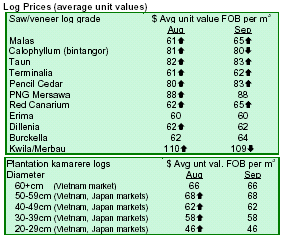
7. BRAZIL
Prices surge due to further weakening of the US dollar
Prices of wood products in Brazil in Brazilian reais remained stable in November 2006 but surged almost 1%
in US dollars due to the continued appreciation of the reais.
Tropical timber exports recover again in October
Exports of solid wood products rose 5.8% to $332 million in October, compared with the same month last year.
Exports of pine sawnwood fell 29.5% to $15.2 million (down 31% to 76,600 m3) while those of tropical sawnwood
eased 0.3% to $51.3 million in spite of the export volume falling 10% to 129,800 m3. Exports of pine plywood
plunged 53% to $24.3 million (down 52% to 90,300 m3) while those of tropical plywood rose 28% to $20.1 million
(up 4% to 40,400 m3). Exports of processed solid-wood products rose in October. Furniture exports recovered
from the downward trend, rising 2.9% to $70.5 million. Rising exports were also registered in wood flooring (up
71.2%), marquetry/furniture pieces (up 39.1%), carpentry/woodworking (up 37.7%) and mouldings (31%).
Such increases helped to counterbalance declining pine/tropical sawnwood and pine plywood.
Furniture sector also faces domestic challenges
Brazilian furniture producers have experienced a crisis in both export and domestic markets in 2006. According to
the Furniture Excellence Central, the sector has failed toreach domestic consumers as only two type of furniture
are available, low and high-quality furniture. There is no
intermediate furniture type, which is estimated to represent about 50% of the potential domestic consumption. The
Brazilian culture has also contributed to the stagnation of the sector. The estimated potential consumption of
furniture in Brazil was 20 billion reais for 2005, but only 14.9 billion reais was actually achieved. The average time
to shift home furniture in Brazil is about ten years compared with 4-5 years in the USA. If the average time
were reduced to eight years, 4 billion reais more would be consumed per year.
APEX partnership boosts Brazil¡¯s presence in int¡¯l fairs
SINDIMADEIRA (Solid-wood Union) of Rio Grande do Sul established a partnership with the Investment and
Exports Agency (APEX), aiming at increasing the participation of Brazilian solid-wood producers in
international fairs. APEX, an agency linked to the Ministry of Development, Industry and Commerce,
guarantees the total or partial funding of renting of exhibition areas and assembly of product stands in
important fairs in UAE, Germany, USA, Japan, Spain France and Russia in 2007. In addition, SINDIMADEIRA
was planning to attend two international business rounds in France and Spain next year.
Solid-wood industry hit by slowing US housing sector
The faltering growth of the US economy has been felt by the Brazilian solid-wood industry. According to
ABIMCI, companies with exports focused on the US housing construction sector, in particular, have been hardest hit.
Producers of pine plywood, who sell over half of the domestic production to the US market, exported 14% less
in the first three quarters of 2006, compared with the same period last year.
By October 2006, US privately-owned housing starts had plunged 34% since January this year (see Report from
North America). For Brazilian solid-wood producers, the effect of the housing slowdown has not only lessened
exports but also reduced prices due to surplus production in the USA. As a result, prices for Brazilian pine plywood
are less competitive not only in North America but also in
Europe. The consequences are growing unemployment in plywood clusters in Brazil. Manufacturers of plywood and
some other solid-wood products have reduced production costs or diminished production to maintain
competitiveness in the international market.
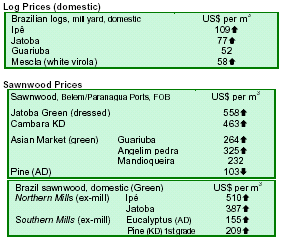
8. PERU
USA absorbs 95% of mahogany sawnwood exports
Peruvian exports of mahogany and cedro (Spanish cedar) sawnwood reached $20.15 million (12,270.3 m3) and
$12.25 (13,687.7 m3), respectively, in the first half of 2006. The average unit values for mahogany and cedro
sawnwood were $1,642 and $895 per m3, respectively, during the period. The chart shows that about 95% of the
mahogany export value (87% of the volume) went to the USA. Peru¡¯s cedro export markets were comparatively
more diversified. The USA accounted for 56% of the export value (52% of the volume) while Mexico and the
Caribbean absorbed 43% of the export value (47% of the volume).
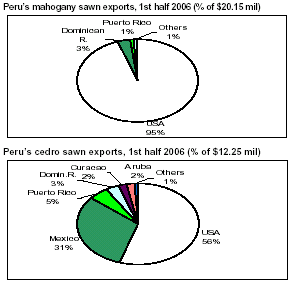
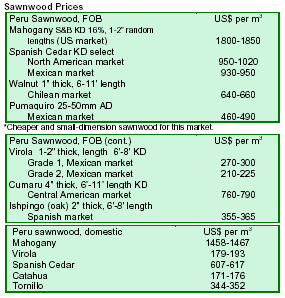
9. BOLIVIA
Santa Cruz¡¯s wood product exports expand in 2006
Exports of wood products from Santa Cruz, the most important Bolivian forestry state, amounted to $30.6
million in the first three quarters of 2006, up 10% from the same period in 2005. Exports to the USA accounted for
35% ($10.8 million) of the value. Secondary processed wood products, such as doors, furniture and wood
flooring, accounted for 62% of the exports while sawnwood accounted for the balance.
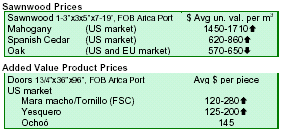
10. Guatemala
Guatemala exports of certified wood products grow
Guatemalan exports of wood products totaled $42.5 million in the first three quarters of 2006, up 12% from the
same period in 2005. Exports of certified wood products accounted for 11% of this value. Swietenia
macrophylla, Lonchocarpus castilloi, Callophylum brasiliense, Cedrela odorata and Dalbergia sp accounted for 72% ($3.4
million) of the exports of certified wood products.

11.
Guyana
India and China emerge as Guyana¡¯s major destinations
With 2006 still to be completed, export earnings for forest products has surpassed the level achieved in 2005. India
has now replaced the USA as Guyana¡¯s top destination for wood products. The top five destinations for Guyanese
wood products in 2006 in descending order are: India, UK, China, Barbados and USA. In 2005, the top five
destinations were the USA, UK, Barbados, India and China. The drop in sales to the USA was due mainly to a
decrease in plywood sales. India and China accounted for most of the logs exported from Guyana while sales to the UK and Barbados were mostly sawn lumber.
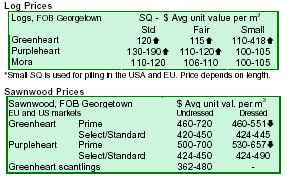
|